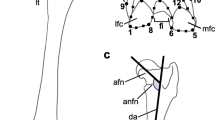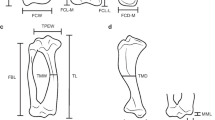Abstract
The aim of this study is to analyze shape variation in the xenarthran femur to gain insights into their behavior and locomotion. Specimens of both Cingulata (armadillos and glyptodonts) and Pilosa (anteaters and sloths) were studied and within each group body mass varies by several orders of magnitude. The main focus of the analysis was allometric variation in femoral shape in the three groups studied, armadillos, glyptodonts, and pilosans. Three dimensional coordinates were recorded for 40 homologous landmarks on each of 51 xenarthran femurs. The data were analyzed by geometric morphometric methods, and form space analysis was used to identify the allometric variation in each of the three groups. Across all groups, larger specimens tended to have larger articular surfaces, more robust femora generally, and the shape of the femoral condyles was more suited to extended postures. In addition, in larger specimens the medial condyle was much larger than the lateral condyle and the third trochanter was located more distally. The larger armadillo femora had a greater trochanter located considerably proximal to the femoral head and this is thought to improve femoral extension, but in glyptodonts and pilosans the larger specimens had a greater trochanter that was far lateral to the femoral head and this is interpreted as enhancing femoral rotation.






Similar content being viewed by others
References
Aguiar JM, Fonseca GAB (2008) Conservation status of the Xenarthra,. In: Vizcaíno SF, Loughry WJ (eds) The Biology of the Xenarthra. University Press of Florida, Gainesville, pp 215–281
Alexander RM, Fariña R, Vizcaíno SF (1999) Tail blow energy carapace fractures in a large glyptodont (Mammalia, Xenarthra). Zool J Linn Soc 126: 41–49
Aramayo SA, Manera de Bianco T (1996) Edad y nuevos hallazgos de icnitas de mamíferos y aves en el yacimiento paleo icnológico de Pehuen-Co (Pleistoceno Tardío), Provincia de Buenos Aires, Argentina. Asociación Paleontológica Argentina, publicación especial 4: 47–57
Argot C (2002) Functional-adaptive anatomy of the hindlimb in the Didelphidae, and the paleobiology of the Paleocene marsupials Mayulestes ferox and Pucadelphys andinus. J Morphol 253: 76–108
Bargo MS, Vizcaíno SF, Archuby FM, Blanco RE (2000) Limb bone proportions, strength and digging in some Lujanian mylodontid ground sloths. J Vertebr Paleontol 20: 601–610
Biewener AA (2000) Scaling of terrestrial support: differing solutions to mechanical constraints of size. In: JH Brown, GB West (eds) Scaling in Biology. Oxford University Press, Oxford, pp 51–66
Blanco RE, Czerwonogora A (2003) The gait of Megatherium Cuvier 1796 (Mammalia, Xenarthra, Megatheridae). Senckenberg Biol 83: 61–68
Blanco RE, Jones WW, Rinderknecht A (2009) The sweet spot of a biological hammer: the centre of percussion of glyptodont (Mammalia: Xenarthra) tail clubs. Proc R Soc, Ser B 276: 3971–3978
Candela AM, Picasso MBJ (2008) Functional anatomy of the limbs of Erethizontidae (Rodentia, Caviomorpha): indicators of locomotor behavior in Miocene porcupines J Morphol 269: 552–593
Casinos A (1996) Bipedalism and quadrupedalism in Megatherium: an attempt at biomechanical reconstruction. Lethaia 29: 87–96
Fariña RA (1995) Limb bone strength and habits in large glyptodonts. Lethaia 28: 189–196
Fariña RA, Blanco RE (1996). Megatherium, the stabber. Proc R Soc, Ser B 263: 1725–29
Fariña RA, Vizcaíno SF, Bargo MS (1998) Body size estimations in Lujanian (late Pleistocene-early Holocene of South America) mammal megafauna. J Neotrop Mammal 5(2): 87–108
Frechkop S (1949) Notes sur les Mammiféres XXXVI. Explication biologique, fournie par les tatous, d’un des caracteares distinctifs analogues chez les pangolins. Bull Inst Sci Nat Belg 25: 1–12
Gaudin TJ, McDonald HG (2008) Chapter 3: Morphology-based investigations of the phylogenetic relationships among extant, fossil xenarthrans. In: Vizcaíno SF, Loughry WJ (eds) Biology of the Xenarthra. University of Florida Press, Gainesville, pp 24–36
Humphry GM (1869) The myology of the limbs of the unau, the ai, the two-toed ant-eater, the pangolin. J Anat Phys 4: 17–78
Inman VT (1966) Human Locomotion. Can Med Assoc J 94: 1047–1054
Jouffroy FK (1971) Musculature des members. In: Grassé PP (ed) Traité de Zoologie, Tome XVI, 3 fasc. Masson, Paris, pp 1–476
Koneval TO (2003) Comparative hindlimb anatomy and fossoriality of three armadillos: Dasypus novemcinctus, Tolypeutes matacus, and Chaetophractus vellerosus (Mammalia, Xenarthra Cingulata, Dasypodidae). PhD thesis University of Massachusetts
Kraglievich LJ (1934) La antigüedad Pliocena de las Faunas de Monte Hermoso y Chapadmalal, deducidas de su comparación con las que le precedieron y sucedieron. El Siglo Ilustrado, Montevideo
Macalister A (1869) On the myology of Bradypus tridactylus; with remarks on the general anatomy of the Edentata. Ann Mag Nat Hist 4:51–67
McDonald HG (2007) Biomechanical inferences of locomotion in ground sloths: integrating morphological, track data. In: Lucas SG, Spielmann JA, Lockley MG (eds) Cenozoic Vertebrate Tracks and Traces. New Mexico Mus Nat Hist Sci Bull 42: 201–208
McDonald HG, De Iuliis G (2008) Fossil history of sloths. In: Vizcaíno SF, Loughry WJ (eds) Biology of the Xenarthra. University of Florida Press, Gainesville, FL. pp. 24–36
Milne N, Vizcaíno SF, Fernicola JC (2009) A 3D geometric morphometric analysis of digging ability in the extant and fossil cingulate humerus. J Zool Lond 278: 48–56
Nowak RM (1999) Walker’s Mammals of the World, 6th edition. Johns Hopkins University Press, Baltimore
Nyakatura JA, Fischer MS (2010a) Three-dimensional kinematic analysis of the pectoral girdle during upside-down locomotion of two-toed sloths (Choloepus didactylus, Linné 1758). Front Zool 7(1):21
Nyakatura JA, Fischer MS (2010b) Functional morphology and three-dimensional kinematics of the thoraco-lumbar region of the spine of the two-toed sloth. J Exp Biol 213(24):4278–4290
O’Higgins P, Jones N (1998) Facial growth in Cercocebus torquatus: an application of three dimensional geometric morphometric techniques to the study of morphological variation. J Anat 193: 251–272
Pujos F, De Iuliis G, Werdelin L (2007) A peculiar climbing Megalonychidae from the Pleistocene of Peru and its implications for sloth history. Zool J Linn Soc 149: 179–235
Quintana CA (1992) Estructura interna de una paleocueva, posiblemente de un Dasypodidae (Mammalia, Edentata) del Pleistoceno de Mar del Plata (Provincia de Buenos Aires, Argentina). Ameghiniana 29: 87–91
Salas R, Pujos F, Muizon C de (2005) Ossified meniscus and cyamofabella in some fossil sloths: a morpho-functional interpretation. Geobios 38:389–394
Sargis EJ (2002) Functional morphology of the hindlimbs of tupaiids (Mammalia, Scandentia) and its phylogenetic implications. J Morphol 254: 149–185
Schmidt-Nielsen K (1984) Scaling: Why is Animal Size So Important? Cambridge University Press, Cambridge
Taber FW (1945) Contribution on the life history and ecology of the nine-banded armadillo. J Mammal 26: 211–226.
Talmage RV, Buchanan GD (1954) The armadillo (Dasypus novemcinctus). A review of its natural history, ecology, anatomy and reproductive physiology. Rice Inst Pamph Mono Bio 4: 1–135
Tardieu C (1983) L’Articulation du genou. Analyse morpho-fontionnelle chez les Primates. Application aux Hominidés fossiles. Cahiers de Paleoanthropologie. Editions du CNRS, Paris
Toledo PM de (1998) Locomotor patterns within Pleistocene sloths. PhD diss, University of Colorado, Boulder
Vizcaíno SF, Bargo MS, Fariña RA (2008) Form, function, and paleobiology in xenarthrans. In: Vizcaíno SF, Loughry WJ (eds) Biology of the Xenarthra. University of Florida Press, Gainesville, pp 86–99
Vizcaíno SF, Blanco RE, Bender JB, Milne N (2010) Proportions and function of the limbs of glyptodonts (Mammalia, Xenarthra). Lethaia 44: 93–101
Vizcaíno SF, Milne N (2002) Structure and function in armadillo limbs (Mammalia, Xenarthra: Dasypodidae). J Zool Lond 257: 117–127
Vizcaíno SF, Milne N, Bargo MS (2003) Limb reconstruction of Eutatus seguini (Mammalia: Xenarthra: Dasypodidae). Paleobiological implication. Ameghiniana 40(1): 89–101
Vizcaíno SF (2009) The teeth of the “toothless”: novelties and key innovations in the evolution of xenarthrans (Mammalia, Xenarthra). Paleobiology 35 (3): 343–366
White JL (1993) Indicators of locomotor habits in xenarthrans: evidence for locomotor heterogeneity among fossil sloths. J Vertebr Paleontol 13: 230–242
Zurita AE, Aramayo SA (2006) New remains of Eosclerocalyptus tapinocephalus (Cabrera) (Mammalia, Xenarthra, Glyptodontidae): description and implications for its taxonomic status. Riv Ital Paleontol S 113:57–66
Acknowledgements
The authors acknowledge M. Reguero, L. Pomi, and I. Olivares (Museo de La Plata), A. Kramarz (Museo Argentino de Ciencias Naturales “Bernardino Rivadavia”, Buenos Aires), and A. Tauber (Museo Regional Provincial Padre Molina) for access to collections. This is a contribution to the projects PIP-CONICET 1054, PICT 0143 and UNLP N 674.
Author information
Authors and Affiliations
Corresponding author
Appendix
Appendix
Rights and permissions
About this article
Cite this article
Milne, N., Toledo, N. & Vizcaíno, S.F. Allometric and Group Differences in the Xenarthran Femur. J Mammal Evol 19, 199–208 (2012). https://doi.org/10.1007/s10914-011-9171-0
Published:
Issue Date:
DOI: https://doi.org/10.1007/s10914-011-9171-0




